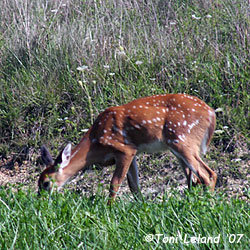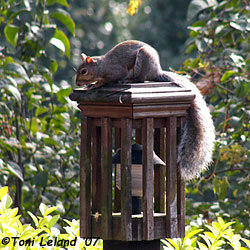Whether your nemesis is deer, or burrowing rodents that dine on your bulbs and ornamentals, plant these critter-resistant varieties, then sit back and smile.
(Editor's Note: This article was originally published on May 5, 2008. Your comments are welcome, but please be aware that authors of previously published articles may not be able to promptly respond to new questions or comments.)
Gardeners have long battled (and lost many skirmishes) against marauding wildlife. In the dead of night, or sometimes in broad daylight, furry creatures help themselves to snacks from the vegetable garden and shrub border. Numerous home remedies are reputed to keep critters at bay, and an entire industry has created all sorts of commercial products that claim to repel animals and protect your prized plants. But the best defense is a good offense: choose plants that aren't attractive to animals in the first place. No plant is 100% wildlife-proof. If animals are hungry enough, they'll eat almost anything. But here's a long list of plants to consider if wildlife is a problem in your garden.
- Abyssinian Gladiolus/Sword Lily - Acidanthera murielae (Zones 7 to 11)
- Astilbe/False Spirea (Zones 4 to 9)
- Autumn Crocus - Colchicum spp. (Zones 4 to 8)
- Begonia (Zone 10)
- Black-eyed Susan - Rudbeckia (Zones 3 to 9)
- Bleeding Hearts - Dicentra (Zones 3 to 9)
- Bluebell or Hyacinth - Hyacinthus spp. (Zones 4 to 8)
- Butterfly Plant - Buddleia (Zones 4 to 10)
- Caladium (Zones 10 to 11)
- Calla Lily (Zones 9 to 11)
- Canna (Zones 7 to 11)
- Climbing Lily - Gloriosa rothschildiana (Zones 7 to 11)
- Common Snowdrop - Galanthus nivalis (Zones 3 to 8)
- Coral Bells - Heuchera (Zones 4 to 8)
- Crocosmia (Zones 5 to 8)
- Crocus tommasinianus (Zones 3 to 8)
- Crownvetch - Coronilla varia (Zones 3 to 9)
- Daffodil - Narcissus spp. (Zones 4 to 11)
- Cone Flower - Echinacea (Zones 3 to 8)
- Elephant Ears - Colocasia (Zones 8 to 10)
- English Lavender - Lavandula angustifolia (Zones 6 to 9)
- Foxglove - Digitalis purpurea (Zones 4 to 9)
- Foxtail Lilies - Eremurus (Zones 4 to 8)
- Fritillary - Fritillaria spp. (Zones 4 to 8)
- Gayfeather - Liatris (Zones 3 to 9)
- Gentian - Gentiana makinoi (Zones 6 to 8)
- Glory of the Snow - Chionodoxa spp. (Zones 4 to 8)

- Grape Hyacinth - Muscari spp. (Zones 4 to 9)
- Hardy Cyclamen - Cyclamen hederifolium (Zones 5 to 9)
- Hardy Fern (Zones 3 to 8)
- Hardy Fuchsia (Zones 8 to 10)
- Hardy Geranium/Cranesbill (Zones 4 to 8)
- Hardy Tall Phlox - Phlox paniculata (Zones 3 to 8)
- Himalayan Lily - Cardiocrinum giganteum (Zones 7 to 10)
- Honeysuckle - Lonicera 'serotina' (Zones 3 to 8)
- Hydrangea (Zones 4 to 8 or 9/3 to 8)
- Spring Star Flower - Ipheion spp. (Zones 4 to 9)
- Larkspur - Delphinium (Zones 3 to 9)
- Lily of the Valley (Zones 2 to 7)
- Louisiana Iris (Zones 4 to 10)
- Ornamental Onion - Allium spp. (Zones 4 to 8)
- Peony - Paeonia (Zones 3 to 9)
- Periwinkle - Vinca minor (Zones 4 to 9)
- Prairie Mallow - Sidalcea (Zones 5 to 9)
- Quamash - Camassia spp. (Zones 4 to 8)
- Rock Soapwort - Saponaria ocymoides (Zones 3 to 9)
- Russian Sage - Perovskia atriplicifolia (Zones 5 to 9)

- Sage - Salvia (Zones 4 to 9)
- Sambucus nigra (Zones 4 to 9)
- Sea Holly - Eryngium (Zones 5 to 8)
- Sedum (Zones 4 to 8)
- Shamrock or Sorrel - Oxalis spp. (Zones 7 to 10)
- Siberian Iris - Iris sibirica (Zones 3 to 9)
- Snowflake - Leucojum spp. (Zones 4 to 8)
- Spanish Bluebell - Hyacinthoides hispanica (Zones 4 to 10)
- Squill - Scilla spp. (Zones 4 to 10)
- Star-of-Bethlehem - Ornithogalum spp. (Zones 5 to 8)
- Summer Tulip - Curcuma alismatifolia (Zones 7 to 9)
- Thymus praecox (Zones 3 to 8)
- Tritoma - Kniphofia (Zones 6 to 9 or 10 dep.reg.)
- Trumpet Creeper - Campsis (Zones 6 to 10)
- Verbascum (Zones 5 to 10)
- Veronica (Zones 4 to 7)
- Winter Aconite - Eranthis spp. (Zones 4 to 7)
NOTE: Zones were taken from national nursery catalogs and various state extension fact sheets, and may differ slightly from other data resources, depending on plant variety.







